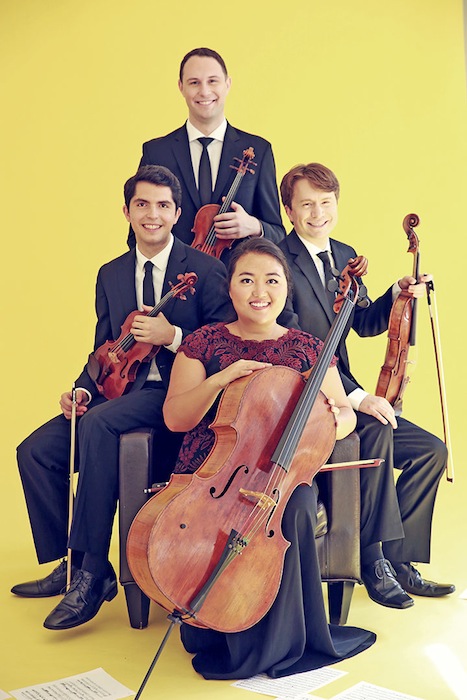Calidore Quartet makes a subtly nuanced Kennedy Center debut

The Calidore String Quartet performed music of Haydn, Kurtág and Brahms Wednesday night at the Kennedy Center’s Terrace Theater. Photo: Sophie Zhai
Formed in 2010, the Calidore String Quartet has been racking up significant awards and fellowships in its short life. The Fortas Chamber Music Concerts series presented the ensemble’s Kennedy Center debut Wednesday night, in a Hungarian-themed program at the Terrace Theater.
The reason for their rapid rise was immediately evident: an intense but soft sound, perfectly balanced among the four instruments.
The group’s approach was optimal for the opening Haydn work, the String Quartet in D Major, known as “The Lark.” The musicians ambled through the first movement, setting a chummy tempo that suited the low-key humor of the music. First violinist Jeffrey Myers displayed impeccable intonation, suspending the movement’s main theme on his sweet tone, as if buoyed by a puff of air; his light touch likewise conveyed why the little chirpy cadenza gave the work its nickname.
Not all string quartets understand the importance of understatement in Haydn’s music, but the Calidore used it to their advantage in the slow movement as well where all the complex variations locked into place. The only misstep was the Menuetto, taken too fast for the tempo marking of Allegretto, with the playful chromatic grace notes and the details of the contrapuntal trio flying by in a blur. The fourth movement, even at its brilliant tempo featuring the extraordinary facility of Myers’s left hand in the constant runs for first violin, had less of a striking contrast as a result.
Second violinist Ryan Meehan spoke engagingly about the most recent work on the program, Officium breve in memoriam Andreae Szervánszky by Hungarian composer György Kurtág. The piece is an homage to both Szervánszky, a friend of Kurtág’s, and Anton Webern, one of Kurtág’s musical idols. Like much of Webern’s music, this work’s fifteen brief movements, some as short as a few seconds, are rarefied distillations of sound, wisps of intense flavor like consommé.
Unlike Webern, the styles that Kurtág has boiled down so vividly are tonal as well as atonal. Corrosively dissonant sections rubbed elbows with blithely consonant ones, and the musicians savored every sweetmeat with perfect intonation and a vast dynamic range. The room was so quiet and the playing so gentle that a number of cell-phone rings and buzzes were easily overheard.
After the yowl of anger in the fourteenth movement, marked “Disperato, vivo,” Kurtág quotes the backbone of the piece, a section of music by the work’s namesake. A major chord crept into the air from the lower strings, over which the two violins mused over this dulcet tune. Just at the moment of greatest yearning, where one’s ear leaned in to hear the exquisite resolution to follow, the piece ended abruptly, an apt musical metaphor for the death of a composer.
The delicate ethos of the Calidore Quartet brushed up against some limitations in the final work, Brahms’ meaty Quartet in C Minor, Op. 51, no. 1. As in the Haydn the clarity of articulation in the first movement made the inner lines of the development section crystal clear, but the climaxes lacked the needed power. The second movement, Romanze, was likewise expertly balanced and refined, with warm and dark-hued contributions from both cellist Estelle Choi and violist Jeremy Berry.
The combination of clean and expressive but soft sound and the lack of a fuller forte in the Brahms finale, gave the impression that the group might be playing on gut or synthetic strings that were partly responsible for their distinctive tone. As in the Haydn quartet, the third movement lost most of its details because of a tempo that seemed too fast, making the rapid character shifts too quick, although the trio bristled with a delightful folk music-like sparkle.


